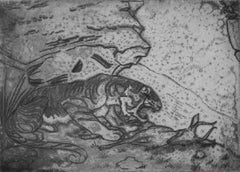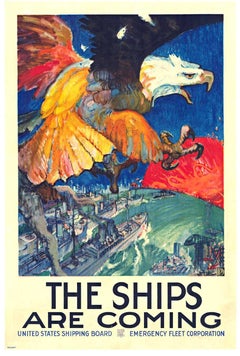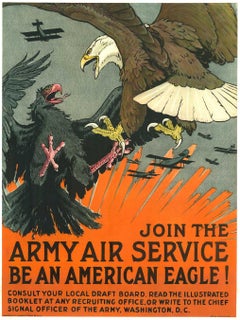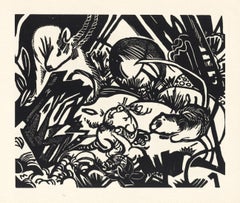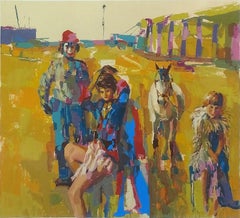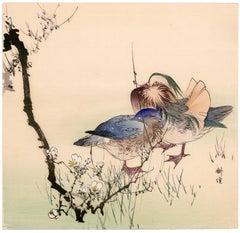1910s Animal Prints
to
6
12
9
7
12
7
1
10
5
4
1
Overall Height
to
Overall Width
to
8
2
1
8
8
6
4
4
3
3
3
2
2
2
2
2
2
2
2
1
1
1
1
687
1,564
2,473
2,505
30
21
76
156
97
135
223
511
325
339
654
3
3
2
2
2
7
7
4
4
3
Period: 1910s
The Bull Der Stier - German Expressionism Bull Der Sturm
By Franz Marc
Located in London, GB
This woodcut by Franz Marc is hand signed in pencil by the artist’s wife "Maria Marc", verso.
The paper also bears the violet inkstamp, verso "Handdruck vom Originalholzstock bastaet...
Category
Expressionist 1910s Animal Prints
Materials
Woodcut
La Proie by Orovida Pissarro, 1917 - Etching Print
Located in London, GB
*UK BUYERS WILL PAY AN ADDITIONAL 20% VAT ON TOP OF THE ABOVE PRICE
La Proie by Orovida Pissarro (1893 - 1968)
Etching
12.5 x 17.5 cm (4 ⅞ x 6 ⅞ inches)
Signed and dated 1917
Trial ...
Category
1910s Animal Prints
Materials
Etching
Original "The Ships Are Coming" vintage American poster with an Eagle.
By James Henry Daugherty
Located in Spokane, WA
Original: THE SHIPS ARE COMING vintage poster. Artist: James H. Daugherty (1889-1974)
Publisher: U.S. Shipping Board, Emergency Fleet Corporation, Publication Section, Philadelphia, 1917.
Poster showing a giant eagle...
Category
American Modern 1910s Animal Prints
Materials
Lithograph
Original 1918 "Join the Army Air Service, Be An American Eagle!" vintage poster
Located in Spokane, WA
Original U. S military World War 1 poster: Join the ARMY AIR SERVICE Be an American Eagle! Consult your local draft board. Read the illustrated booklet at any recruiting office, or write to the Chief Signal Officer of the Army, Washington D. D.
Linen backed in very good condition; ready to frame. Professionally restore fold marks that are inconspicuous.
Artist: Charles Livingston Bull
Extremely rare original World War 1 poster. When you research all the major museums that have a copy of this poster, it is usually in bad shape with missing paper. This original c. 1917 has no missing paper and is bright and vibrant. It should be in the finest condition original available.
Explore
The United States Army Air Service was the aerial warfare service component of the United States Army between 1918 and 1926 1. It was established as an independent but temporary branch of the U.S. War Department during World War I by two executive orders of President Woodrow Wilson: on May 24, 1918, replacing the Aviation Section, Signal Corps as the nation’s Air Force, and March 19, 1919, establishing a military Director of Air Service to control all aviation activities. Its life was extended for another year in July 1919, during which time Congress passed the legislation necessary to make it a permanent establishment. The National Defense Act of 1920 assigned the Air Service the status of “combatant arm of the line” of the United States Army with a major general in command.
Charles Livingston Bull (1874-1932) was an American illustrator known for his illustrations of wildlife. Bull studied taxidermy in Rochester, New York, and his first job at the age of 16 was preparing animals for mounting at the Ward’s Museum in Rochester, New York. During World War I, he designed recruiting posters, including the famous Join the Army Air Service poster...
Category
American Modern 1910s Animal Prints
Materials
Lithograph
Original "Are You 100% American, Prove It! Third Liberty Loan vintage poster
Located in Spokane, WA
Original " Are You 100% American? Prove it! Buy US government bonds. Third Liberty Loan" vintage poster.
This poster from World War I questions whether the viewer is genuinely A...
Category
American Modern 1910s Animal Prints
Materials
Lithograph
"Aus der Tierlegende" original woodcut
By Franz Marc
Located in Henderson, NV
Medium: original woodcut. Catalogue reference Lankheit 831-3. Published in 1919 for Genius. Image size: 7 3/4 x 9 1/2 inches (198 x 240mm). This is a very richly inked impression pri...
Category
Expressionist 1910s Animal Prints
Materials
Woodcut
Curves by Orovida Pissarro, 1919 - Etching Print
Located in London, GB
Curves by Orovida Pissarro (1893 - 1968)
Etching, trial proof no. 54
20.2 x 15 cm (8 x 5 ⅞ inches)
Signed and dated lower right, Orovida 1919
Inscribed lower left Trial proof no. 54 ...
Category
Post-Impressionist 1910s Animal Prints
Materials
Paper, Etching
English early 20th century, An Irish Hare and a Mountain hare in a landscape
Located in Woodbury, CT
Wonderful Vintage Archibald Thorburn colored chromolithograph.
The colors are amazing, giving the painting a really great appearance .
Printed circa 1919, the picture is inscribed ...
Category
Victorian 1910s Animal Prints
Materials
Paper
Original "At The Front! Enlist Now" British vintage poster
Located in Spokane, WA
Origiinal WW1 poster: AT THE FRONT! Every fit Briton should join our brave men at the front. Enlist NOW. . Artist: Lionel Edwards.
Original, Mint, Linen-backed original World War 1 rare stone lithographic poster. At the front! Every fit Briton should join our brave men at the front. Enlist now / printed by E.S. & A. Robinson Ltd., Bristol. London: Parliamentary Recruiting Committee, [1915]. Poster showing cavalry in battle, with horses reacting to an explosion in the foreground.
Until March 2, 1916, when the Military Service Act introduced conscription, Great Britain’s World War I army was comprised entirely of volunteers. Many of the most famous wartime posters...
Category
American Realist 1910s Animal Prints
Materials
Lithograph
La Poursuite by Orovida Pissarro - Animal etching
Located in London, GB
La Poursuite by Orovida Pissarro (1893-1968)
Etching with aquatint
17.2 x 12.5 cm (6 ³/₄ x 4 ⁷/₈ inches)
Signed and dated lower right Orovida 1917
Inscribed lower left Final State Trial proof no. 1
Artist biography
Orovida Camille Pissarro, Lucien and Esther Pissarro’s only child, was the first woman in the Pissarro family as well as the first of her generation to become an artist. Born in Epping, England in 1893, she lived and worked predominantly in London where she became a prominent member of several British arts clubs and societies.
She first learned to paint in the Impressionist style of her father, but after a brief period of formal study with Walter Sickert in 1913 she renounced formal art schooling. Throughout her career, Orovida always remained outside of any mainstream British art movements. Much to Lucien's disappointment she soon turned away from naturalistic painting and developed her own unusual style combining elements of Japanese, Chinese, Persian and Indian art. Her rejection of Impressionism, which for the Pissarro family had become a way of life, together with the simultaneous decision to drop her famous last name and simply use Orovida as a ‘nom de peintre’, reflected a deep desire for independence and distance from the weight of the family legacy.
Orovida's most distinctive and notable works were produced from the period of 1919 to 1939 using her own homemade egg tempera applied in thin, delicate washes to silk, linen or paper and sometimes embellished with brocade borders. These elegant and richly decorative works generally depict Eastern, Asian and African subjects, such as Mongolian horse...
Category
1910s Animal Prints
Materials
Aquatint, Etching
Antique Rooster Woodblock Print circa 1910 by Prosper Alphonse Isaac
Located in SANTA FE, NM
Antique Rooster Portrait
Prosper Alphonse Isaac (France, 1858-1924)
Woodblock Print circa 1910
9 x 7 1/8 (15 1/4 x 17 frame) inches
The excellent book "The Great Wave: The Influence of Japanese Woodcuts on French Prints" which was an exhibition at The Metropolitan Museum of Art in 1974, recounts the phenomenal "cult of Japan" in late nineteenth-century France and reveals through direct comparisons its particular impact on the graphic work of Manet, Degas, Cassatt, Bonnard, Vuillard, Toulouse-Lautrec, and Gauguin. This print directly relates to the discovery of Japanese art most notably through the woodblock prints which found their way to the West oftentimes as stuffing or packing materials from consumer goods that were being imported to the West at the end of the 19th century.
Prosper-Alphonse Isaac was born in a well-to-do family. This gave him the means not only of leaving his native Calais to pursue a career as an artist in Paris, but also the means to acquire art. Isaac was particularly drawn to Japanese arts, which he collected avidly. Many of the objects he bought were eventually given to museums. As a printmaker Isaac started drawing seascapes in dry point, but eventually moved on to become one of only a handful of artists versed in color woodcut techniques in France. His compositions, generally small in scale, are heavily influenced by the arts of Japan. He printed small editions of these works. Aside from this artistic activity, Isaac was also an active textile decorator.
"This mark, which he borrows from Hokusaï and Totoya Hokkeï...
Category
Art Nouveau 1910s Animal Prints
Materials
Ink, Laid Paper
Original 'Cleveland War Fund, All for Victory' vintage lithograph poster
Located in Spokane, WA
Original CLEVELAND WAR FUND, ALL FOR VICTORY, vintage poster, museum linen backed. Presents in Good condition B+ due to restored tears. Printer: The Central Lithograph Co., Cleveland.
Original World War One poster. Museum linen backed.
Restored original fold lines. No paper loss, full lithograph. Please see the large images for the minor defects.
Promoting the Salvation Army...
Category
American Realist 1910s Animal Prints
Materials
Lithograph
English early 20th century, A Common Hare in a landscape
Located in Woodbury, CT
Wonderful Vintage Archibald Thorburn colored chromolithograph.
The colors are amazing, giving the painting a really great appearance .
Printed circa 1919, the picture is inscribed ...
Category
Victorian 1910s Animal Prints
Materials
Paper
SEEING NEW YORK
By John Sloan
Located in Portland, ME
Sloan, John. SEEING NEW YORK. M.188. Etching, 1917. Signed, titled, and inscribed "100 Prrofs," all in pencil. Edition of 100, of which only 85 were printed.
The image is of live ch...
Category
1910s Animal Prints
Materials
Etching
A Fierce Bull
By James McBey
Located in Storrs, CT
A Fierce Bull. 1911. Drypoint. Hardie 108. 5 3/8 x 8 (sheet 8 5/16 x 11 7/8). Edition 8. An exceptional impression with rich drypoint burr printed on antique laid paper. A proof of t...
Category
Modern 1910s Animal Prints
Materials
Drypoint, Etching
The Matador.
By James McBey
Located in Storrs, CT
The Matador. 1911. Drypoint. Hardie 109. 6 7/8 x 10 7/8 (sheet 7 7/8 x 12). Edition 15. A few scattered foxing marks and slight mat line; otherwise fine o...
Category
Modern 1910s Animal Prints
Materials
Drypoint, Etching
Das Grosse Tier II - Etching by Richard Muller - 1919
Located in Roma, IT
Das Grosse Tier II is an original etching and drypoint, realized by Richard Müller in 1919, signed on the plate, numbered 60/74 and signed in pencil l...
Category
Symbolist 1910s Animal Prints
Materials
Etching
Ausgedient - Lithograph by Ferdinand Andri - 1917
Located in Roma, IT
Ausgedient (“Obsolete”) is an original artwork realized by Ferdinand Andri in 1917. Lithograph in black over yellow plate on paper. Published in 1917 as part of a Jahresmappe (Annual...
Category
Modern 1910s Animal Prints
Materials
Lithograph
Aus Albanien
Located in Roma, IT
Aus Albanien ("From Albania") is an original artwork realized by Ferdinand Andri in 1916. Lithograph on yellow plate. Printed by k. k. Hof- und Staatsdruckerei Wien / Albert Berger W...
Category
Modern 1910s Animal Prints
Materials
Lithograph
The Picador Incites the Bull.
By James McBey
Located in Storrs, CT
The Picador Incites the Bull. 1911. Drypoint. Hardie 104. 6 1/4 x 9 7/8 (sheet 8 1/4 x 11 7/8). Edition 30, #5. Slight mat line, 1 hinge stain in the lower margin, well outside the i...
Category
Modern 1910s Animal Prints
Materials
Drypoint
La Fille aux Oies
Located in New York, NY
Jean-Emile Laboureur (1877-1943), La Fille aux Oies, engraving, 1916, signed in pencil lower left, numbered (4/40) lower right and inscribed “imp,” also titled lower left margin edge...
Category
Cubist 1910s Animal Prints
Materials
Engraving
Related Items
Invites Into the World of the Eternal Instant
Located in Lyons, CO
Color lithograph, Ed. 30
Chagoya's newest prints, "Invites Into the World of the Eternal Instant" and "Expresses Nothing but the Self", are concerned with the current unsustainabl...
Category
Contemporary 1910s Animal Prints
Materials
Lithograph
LA FAMILLE DU CIRQUE
Located in Aventura, FL
Serigraph on paper. Hand signed and numbered by the artist. Artwork appears to be in excellent condition. Artwork has not been examined outside the matting. Artwork size: 30 x 33 in....
Category
Expressionist 1910s Animal Prints
Materials
Screen, Paper
Western Pals
By Red Grooms
Located in Lyons, CO
Color lithograph, Edition 40.
Red Grooms is a painter, sculptor, printmaker, filmmaker, and showman par excellence. His major installations, “Ruckus Manhattan”, “The City of Chicago...
Category
Contemporary 1910s Animal Prints
Materials
Lithograph
Schwimmpolypen (Polyps), German antique marine life sea chromolithograph print
Located in Melbourne, Victoria
'Schwimmpolypen'
(Polyps)
German chromolithograph, circa 1895.
250mm by 155mm (sheet)
Category
Naturalistic 1910s Animal Prints
Materials
Lithograph
Hunde II (Hounds, Dogs) German antique animal chromolithograph print
Located in Melbourne, Victoria
'Hunde II'
(Hounds, Dogs)
German chromolithograph, circa 1895. Key to dog breeds in German below the image.
240mm by 310mm (sheet).
Central vertical fold as issued.
Category
Naturalistic 1910s Animal Prints
Materials
Lithograph
Huhnerrassen (Poultry Breeds), German antique chicken bird chromolithograph
Located in Melbourne, Victoria
'Huhnerrassen'
(Poultry Breeds)
German chromolithograph, circa 1895. Key to poultry in German below the image.
245mm by 305mm (sheet).
Central vertical fold as issued.
Category
Naturalistic 1910s Animal Prints
Materials
Lithograph
Algen I (Seaweeds), German antique underwater sealife print
Located in Melbourne, Victoria
'Algen I'
(Seaweeds)
German chromolithograph, circa 1895.
245mm by 305mm (sheet).
Central vertical fold as issued.
Category
Naturalistic 1910s Animal Prints
Materials
Lithograph
Orientalische Fauna (Oriental Fauna), German antique animal chromolithograph
Located in Melbourne, Victoria
'Orientalische Fauna'
(Oriental Fauna)
German chromolithograph, circa 1895. Key to animals in German below the image.
245mm by 305mm (sheet).
Central vertical fold as issued.
Category
Naturalistic 1910s Animal Prints
Materials
Lithograph
Nu Rouge Á L'Oiseau, Signed Lithograph Red Female Nude, Exotic Blue Bird, Erotic
By Corneille
Located in Union City, NJ
Nu Rouge Á L'Oiseau is an original hand drawn limited edition lithograph printed in vivid colors on archival Somerset paper 100% acid, free, by the Dutch artist known as CORNEILLE(Gu...
Category
Expressionist 1910s Animal Prints
Materials
Lithograph
European bird eggs, German antique chromolithograph print
Located in Melbourne, Victoria
'Eier europaischer Vogel II'
(European bird eggs)
German chromolithograph, circa 1895.
305mm by 240mm (sheet).
Central horizontal fold as issued.
Category
Naturalistic 1910s Animal Prints
Materials
Lithograph
Pierre Bonnard ltd edition Lithograph Printed at Mourlot Paris 1958 Chicken, Egg
Located in Surfside, FL
This is from a limited edition portfolio of original lithographs print Fernand Mourlot in Paris in 1958 from work done in collaboration with Bonnard which began in 1928.
This is from the rare first edition, No. VII of 20 unbound sets, specially printed for Hans P. Kraus, with Henry de Montherlant inscription to him signed and dated March 3, 1960
These are not individually hand signed or numbered.
On BFK Rives French velin art paper
Pierre Bonnard (1867 – 1947) was a French painter, illustrator and printmaker, known especially for the stylized decorative qualities of his paintings and his bold use of color. A founding member of the Post-Impressionist group of avant-garde painters Les Nabis, (the Naive artists) his early work was strongly influenced by the work of Paul Gauguin, as well as the prints of Hokusai and other Japanese artists. Bonnard was a leading figure in the transition from Impressionism to Modernism. He painted landscapes, urban scenes, portraits and intimate domestic scenes, where the backgrounds, colors and painting style usually took precedence over the subject.
Pierre Bonnard was born in Fontenay-aux-Roses, Hauts-de-Seine on 3 October 1867. His mother, Élisabeth Metzdorff, was from Alsace. His father, Eugène Bonnard, was from the Dauphiné, and was a senior official in the French Ministry of War. He had a brother, Charles, and a sister, Andrée, who in 1890 married the composer Claude Terrasse.
He received his education in the Lycée Louis-le-Grand and Lycée Charlemagne in Vanves. He showed a talent for drawing and water colors, as well as caricatures. He painted frequently in the gardens of his parent's country home at Grand-Lemps near the Cote Saint-André in the Dauphiné. He also showed a strong interest in literature. He received his baccalaureate in the classics, and, to satisfy his father, between 1886 and 1887 earned his license in law, and began practicing as a lawyer beginning in 1888. While he was studying law, he also attended art classes at the Académie Julian in Paris. At the Académie Julien he met his future friends and fellow artists, Paul Sérusier, Maurice Denis, Gabriel Ibels and Paul Ranson. In 1888 Bonnard was accepted by the École des Beaux-Arts, where he met Édouard Vuillard and Ker Xavier Roussel. He also sold his first commercial work of art, a design for poster for France-Champagne, which helped him convince his family that he could make a living as an artist. He set up his first studio at on rue Lechapelais and began his career as an artist.
From 1893 until her death, Bonnard lived with Marthe de Méligny (1869–1942), and she was the model for many of his paintings, including many nude works. Her birth name was Maria Boursin, but she had changed it before she met Bonnard. They married in 1925. In the years before their marriage, Bonnard had love affairs with two other women, who also served as models for some of his paintings, Renée Monchaty (the partner of the American painter Harry Lachmann) and Lucienne Dupuy de Frenelle, the wife of a doctor; it has been suggested that Bonnard may have been the father of Lucienne's second son. Renée Monchaty committed suicide shortly after Bonnard and de Méligny married.
In 1891 he met Toulouse-Lautrec and in December 1891 showed his work at the annual exhibition of the Société des Artistes Indépendants. In the same year Bonnard also began an association with La Revue Blanche, for which he and Edouard Vuillard designed frontispiece In March 1891, his work was displayed with the work of the other Nabis at the Le Barc de Boutteville. The style of Japanese graphic arts became an important influence on Bonnard. In 1893 a major exposition of works of Utamaro and Hiroshige was held at the Durand-Rouel Gallery, and the Japanese influence, particularly the use of multiple points of view, and the use of bold geometric patterns in clothing, such as checkered blouses, began to appear in his work. Because of his passion for Japanese art, his nickname among the Nabis became Le Nabi le trés japonard. He devoted an increasing amount of attention to decorative art, designing furniture, fabrics, fans and other objects. He continued to design posters for France-Champagne, which gained him an audience outside the art world. In 1892 he began to produce lithographs, and painted two of his early notable works, Le Corsage a carreaux and La Partie de croquet. He also made a series of illustrations for the music books of his brother-in-law, Claude Terrasse. In 1895 he became an early participant of the movement of Art Nouveau, designing a stained glass window, called Maternity, for Tiffany. In 1895 he had his first individual exposition of paintings, posters and lithographs at the Durand-Ruel Gallery. He also illustrated a novel, Marie, by Peter Nansen, published in series by in La Revue Blanche. The following year he participated in a group exposition of Nabis at the Ambroise Vollard Gallery. In 1899, he took part in another major exposition of works of the Nabis.
Throughout the early 20th century, as artistic styles appeared and disappeared with almost dizzying speed, Bonnard kept refining and revising his personal style, and exploring new subjects and media, but keeping the distinct characteristics of his work. Working in his studio at 65 rue de Douai in Paris, he presented paintings at the Salon des Independents in 1900, and also made 109 lithographs for Parallèment, a book of poems by Verlaine. He also took part in an exhibition with the other Nabis at the Bernheim Jeune gallery. He presented nine paintings at the Salon des Independents in 1901. In 1905 he produced a series of nudes and of portraits, and in 1906 had a personal exposition at the Bernheim-Jeune Gallery. In 1908 he illustrated a book of poetry by Octave Mirbeau, and made his first long stay in the South of France, at the home of the painter Manguin in Saint-Tropez. in 1909, and in 1911 began a series of decorative panels, called Méditerranée, for the Russian art patron Ivan Morozov.
During the years of the First World War, Bonnard concentrated on nudes and portraits, and in 1916 completed a series of large compositions, including La Pastorale, Méditterranée, La Paradis Terreste and Paysage de Ville. His reputation in the French art establishment was secure; in 1918 he was selected, along with Renoir, as an honorary President of the Association of Young French Artists. In the 1920s, he produced illustrations for a book by Andre Gide (1924) and another by Claude Anet (1923). He showed works at the Autumn Salon in 1923, and in 1924 was honored with a retrospective of sixty-eight of his works at the Galerie Druet. In 1925 he purchased a villa in Cannes.
In 1938 his works and Vuillard were featured at an exposition at the Art Institute of Chicago. The outbreak of World War II in September 1939, forced Bonnard to depart Paris for the south of France, where he remained until the end of the war. Under the German occupation, he refused to paint an official portrait of the French collaborationist leader, Marechal Petain, but accepted a commission to paint a religious painting of Saint Francis de Sales, with the face of his friend Vuillard, who had died two years earlier. He finished his last painting, The Almond Tree in Blossom, a week before his death in his cottage on La Route de Serra Capoue near Le Cannet, on the French Riviera, in 1947. The Museum of Modern Art in New York City organized a posthumous retrospective of Bonnard's work in 1948, although originally it was meant to be a celebration of the artist's 80th birthday.
Bonnard particularly used the model of Japanese art in a series...
Category
Post-Impressionist 1910s Animal Prints
Materials
Lithograph
Cinq Boules et Deux Serpents, Alexander Calder
Located in Fairfield, CT
Artist: Alexander Calder (1898-1976)
Title: Cinq Boules et Deux Serpents
Year: 1965
Medium: Lithograph in colors on wove paper
Edition: 90, plus proofs
Size: 20.5 x 28.75 inches
Cond...
Category
Modern 1910s Animal Prints
Materials
Lithograph
Previously Available Items
'Mandarin Ducks' — Japanese Woodblock Print, c. 1910
Located in Myrtle Beach, SC
Kogyo Tsukioka, 'Mandarin Ducks', color woodcut, c. 1910. Signed 'Kogyo', lower right. A fine impression from a later printing, on cream Japan paper, with fresh colors; the image printed to the sheet edges, in excellent condition. Image size 9 1/2 x 9 7/8 inches (241 x 251 mm). Archivally sleeved, unmatted.
One of about fifty kacho-e (bird and flower prints) in the shikishiban (almost square) format designed by Tsukioka Kōgyo for the publisher Daikokuya (Matsuki Heikichi) around the turn of 20th century.
ABOUT THE ARTIST
Kogyo Tsukioka (1869-1927) was a Japanese artist of the Meiji period. He was a student and adopted son of Tsukioka Yoshitoshi, and also studied with Ogata Gekkō...
Category
Naturalistic 1910s Animal Prints
Materials
Woodcut
Chicken and Rooster
By Kobayashi Kiyochika
Located in Fairlawn, OH
Chicken and Rooster
Color woodcut with embossing, 1914-1915
Signed: Kiyochika (see photo_
Seal: Artist's red signature seal (See photo)
Publisher: Watanabe (see photo)
Format: Oban
Condition: Excellent
Image size: 11 3/8 x 15 5/8 inches
Provenance: Robert O. Muller Collection (1911-2003), famous collector and dealer
From Wikipedia, the free encyclopedia
Kobayashi Kiyochika
小林清親
Born Kobayashi Katsunosuke
10 September 1847
Edo, Japan
Died 28 November 1915 (aged 68)
Tokyo, Japan
Nationality Japanese
Movement ukiyo-e
Kobayashi Kiyochika (小林 清親, 10 September 1847 – 28 November 1915) was a Japanese ukiyo-e artist, best known for his colour woodblock prints and newspaper illustrations. His work documents the rapid modernization and Westernization Japan underwent during the Meiji period (1868–1912) and employs a sense of light and shade called kōsen-ga [ja] inspired by Western art techniques. His work first found an audience in the 1870s with prints of red-brick buildings and trains that had proliferated after the Meiji Restoration; his prints of the First Sino-Japanese War of 1894–95 were also popular. Woodblock printing fell out of favour during this period, and many collectors[who?] consider Kobayashi's work the last significant example of ukiyo-e.
Life and career
Kiyochika was born Kobayashi Katsunosuke (小林 勝之助) on 10 September 1847 (the first day of the eighth month of the ninth year of Kōka on the Japanese calendar) in Kurayashiki [ja] neighbourhood of Honjo in Edo (modern Tokyo). His father was Kobayashi Mohē (茂兵衛), who worked as a minor official in charge of unloading rice collected as taxes. His mother Chikako (知加子) was the daughter of another such official, Matsui Yasunosuke (松井安之助). The 1855 Edo earthquake destroyed the family home but left the family unharmed.
Though the youngest of his parents' nine children, Kiyochika took over as head of the household upon his father's death in 1862 and changed his name from Katsunosuke. As a subordinate to a kanjō-bugyō official Kiyochika travelled to Kyoto in 1865 with Tokugawa Iemochi's retinue, the first shogunal visit to Kyoto in over two centuries. They continued to Osaka, where Kiyochika thereafter made his home. During the Boshin War in 1868 Kiyochika participated on the side of the shōgun in the Battle of Toba–Fushimi in Kyoto and returned to Osaka after defeat of the shōgun's forces. He returned by land to Edo and re-entered the employ of the shōgun. After the fall of Edo he relocated to Shizuoka, the heartland of the Tokugawa clan, where he stayed for the next several years.
Kiyochika returned to the renamed Tokyo in May 1873 with his mother, who died there that September. He began to concentrate on art and associated with such artists as Shibata Zeshin...
Category
Showa 1910s Animal Prints
Materials
Woodcut
(Fighting Horses)
Located in New York, NY
Christian Ludwig Martin worked in Vienna. He was an artist, illustrator, and teacher. This print is titled (partially indecipherable - 'Pfende' is 'Horses') in German, and signed in pencil. It is on a large sheet. (Fighting Horses...
Category
Modern 1910s Animal Prints
Materials
Drypoint
The Fox and the Geese by Briton Riviere 1868 Lithograph c1918
Located in FR
The Fox and the Geese Lithograph by Briton Riviere 1868
Lithograph c1918
Briton's father, William Rivière (1806–1876), was for some years drawing-master at Cheltenham College, and...
Category
Realist 1910s Animal Prints
Materials
Lithograph
Japanese Crane Lithograph
Located in New York, NY
Original colored lithograph from a portfolio entitled " Nakagawa Zhuanshu." Nagoya, Japan, circa 1917.
Category
1910s Animal Prints
Materials
Paper
Hungry Dogs, Second State
Located in Fairlawn, OH
Hungry Dogs, Second State
Lithograph, 1916
Considered to be the artist's first lithograph
Signed, titled and numbered in pencil by the artist (see photo)
Titled "Hungry Dogs" by the artist in pencil (see photo)
Edition: at least 41 impressions, this "No. 14"
Reference: Masson 1B ii/II
Condition: Printer's ink in margins, otherwise very good condition.
Note: The artist's first lithograph. The "Ash Can School" is derived from this image and its' depiction of an ash can in the lower left of the composition. A very important American 20th Century print. This image gave rise to the naming of the most important American style of painting in the first quarter of the 20th century.
Provenance: Estate of the artist
H. V. Allison & Co., New York (Bellows estate dealer)
Private Collection, Columbus, Ohio (Bellows city of birth)
From 2001 to 2018, Thomas French Fine Art was the exclusive agent for the Bellows Family Trust. Thomas French Fine Art and The Bellows Trust hold a large inventory of original lithographs and drawings created by George Wesley Bellows that were left in the artist’s studio at the time of his unexpected early death. All of George Bellows’ original lithographs were printed by the artist or under his direct supervision. There are no posthumous impressions of any of George Bellows’ lithographs...
Category
American Realist 1910s Animal Prints
Materials
Lithograph
Japanese Rooster Lithograph
Located in New York, NY
Original colored lithograph from a portfolio entitled " Nakagawa Zhuanshu." Nagoya, Japan, circa 1917.
Category
1910s Animal Prints
Materials
Paper
Japanese Bat Lithograph
Located in New York, NY
Original colored lithograph from a portfolio entitled " Nakagawa Zhuanshu." Nagoya, Japan, circa 1917.
Category
1910s Animal Prints
Materials
Paper
Original 1916 Mangez moins de viande pour ménager notre cheptel vintage poster
Located in Spokane, WA
Original French vintage Mangez moins de viande pour ménager notre cheptel color lithographed poster signed "Martha Picard, 16 years old,. Municipal School, Boulevard Pereire 221". Th...
Category
Abstract Expressionist 1910s Animal Prints
Materials
Lithograph
H 21.5 in W 14.5 in D 0.07 in
SPRIGTAIL
By Frank Benson
Located in Portland, ME
Benson, Frank. SPRIGTAIL. Pfaff 151. Etching, 1918. Edition of 50. Signed in pencil. 4 x 5 inches, plate. Framed to 9 7/8 x 12 inches. In excellent condition.
Category
1910s Animal Prints
Materials
Etching
Three Wise Men
By Bertha Boynton Lum
Located in Burbank, CA
Oversized work of three men mounted atop camels who gaze intently into the distance at left, stars glowing in the deep indigo night sky above. A touching and subtle rendering of the Christmas story. There is a mystical flourish in the foreground that appears almost as a glowing ember, with smoke wafting before the travelers. Perhaps it is guiding them, as they seem to follow its direction with their gaze. The pencil annotation seems to read “Copyright 1918 by Bertha Lum...
Category
Art Deco 1910s Animal Prints
Materials
Woodcut
Krankes Pferd
By Oswald Roux
Located in Roma, IT
Krankes Pferd ("Sick Horse") is an original etching realized by Oswald Rouxin 1916. Printed by k. k. Hof- und Staatsdruckerei Wien / Albert Berger Wien; published in the "Jahresmappe...
Category
Modern 1910s Animal Prints
Materials
Etching

